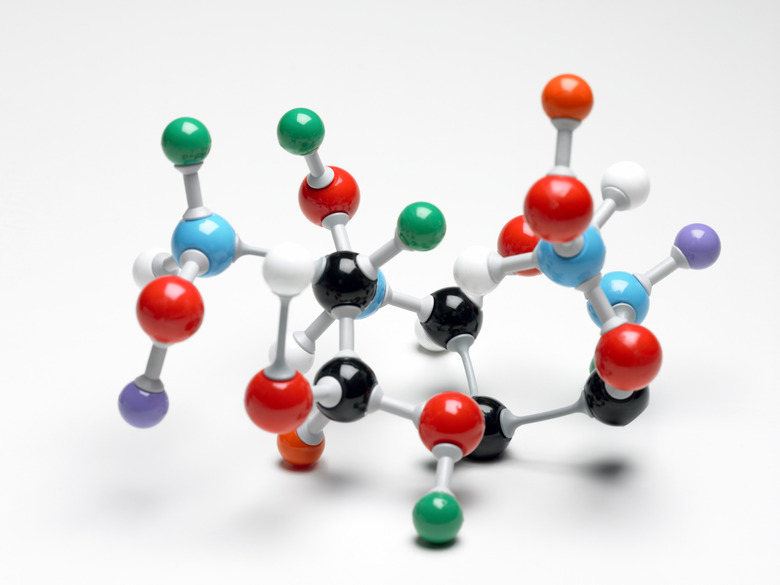Does Bonding Exist In Substances That Consist Of Discrete Molecules?
Bring two magnets close together, and within a certain distance, the two magnets will pull toward each other and then affix. When pulled apart, the magnets are still intact, only separate from each other. If molecules behave in this manner — whether together or pulled apart they retain molecular identity — they are considered discrete molecules.
Discrete vs. Continuous Viewpoint
Discrete vs. Continuous Viewpoint
Discrete molecules retain molecular identity, and such molecules would act as distinct units of matter, like grains of sand. This would explain why molecules or elements could "stick" together in a chemical bond.
To be considered continuous, there would be no sharp divisions, and one element or molecule would blend into another in a chemical bond. This would explain stability or the force of magnetism. Note that molecules are not considered indiscrete.
Discrete versus continuous is analogous to asking whether the constituents of the universe act as particles or waves.
Discrete Molecules and Elemental Forms
Discrete
Molecules and Elemental Forms
In the discrete viewpoint, molecules can be considered discrete in how they act at the molecular level. Discrete particle chemistry considers molecules or elements discrete depending on the lack of interaction.
Elements in their elemental form may be considered discrete. An element in its elemental form is composed of only that element and not combined with other elements. The element would exist free (uncombined) in nature. Such substances, though seemingly simple, are rarely produced in pure form in nature.
All the noble gases exist in elemental form. An example of a metal in elemental form would be gold, as it can be found in nature in its elemental state. Other elements found uncombined are copper, silver, sulfur and carbon.
Discrete Molecules: Diatomic and Other Molecules
Discrete Molecules:
Diatomic and Other Molecules
Several of the nonmetals exist as gases at room temperature and as diatomic molecules: H2, N2, O2, F2, Cl2, I2 and Br2. These act as discrete molecules.
Also, consider molecules such as water that exist in discrete form through different states of matter, such as liquid or solid. When ice melts, it changes state but maintains its discrete identity.
Other solid states would not maintain this discrete identity. For example, common salt, NaCl, breaks into ions in an aqueous state and would not be considered discrete.
Discrete Molecules and Bonding Forces
Discrete
Molecules and Bonding Forces
Discrete molecules would, generally, not interact with other molecules.
Dipole-dipole interactions and London dispersion forces are two intermolecular forces that allow discrete molecules to bond with each other as many small magnets would.
Dipole-Dipole Interactions
Dipole-Dipole Interactions
In dipole-dipole interactions, a partial charge forms within the molecule due to the uneven distribution of electrons. A dipole is a pair of opposite charges separated by a distance. A special case of a dipole-dipole interaction is hydrogen bonding.
Hydrogen bonding happens between two separate molecules. In hydrogen bonding, each molecule must have a hydrogen atom that is covalently bonded to another atom that is more electronegative. The more electronegative atom will pull the shared electrons within the covalent bond toward itself, forming partial positive charges.
For example, consider the water molecule, H2O. Between the hydrogen bond of one water molecule and the oxygen bond of another, there is an interaction based on the partial positive (hydrogen atom) and partial negative (oxygen atom) charges.
These two slight charges turn each discrete water molecule into a weak magnet that will attract other discrete water molecules.
London Dispersion Forces
London
Dispersion Forces
London dispersion forces are the weakest intermolecular force. It is a temporary attraction that happens when electrons on two adjacent atoms interact to form temporary dipoles.
Normally, only polar molecules form dipoles. That is, elements that bind and have a fairly high electronegativity difference. However, even nonpolar molecules, ones that do not have partial electrical charges within them, can have momentary slightly negative charges.
Since electrons are not stationary, it is possible that many of the negatively-charged electrons may be near one end of the molecule. At this moment, the molecule has a slightly (albeit momentary) negative end. At the same time, the other end will be momentarily slightly positive.
This instantaneous dipole creates a momentary polar character and may allow discrete molecules to interact with neighboring molecules.
Cite This Article
MLA
Kozlowski, Rosann. "Does Bonding Exist In Substances That Consist Of Discrete Molecules?" sciencing.com, https://www.sciencing.com/bonding-exist-substances-consist-discrete-molecules-17285/. 26 March 2020.
APA
Kozlowski, Rosann. (2020, March 26). Does Bonding Exist In Substances That Consist Of Discrete Molecules?. sciencing.com. Retrieved from https://www.sciencing.com/bonding-exist-substances-consist-discrete-molecules-17285/
Chicago
Kozlowski, Rosann. Does Bonding Exist In Substances That Consist Of Discrete Molecules? last modified August 30, 2022. https://www.sciencing.com/bonding-exist-substances-consist-discrete-molecules-17285/
